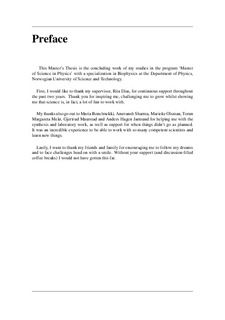| dc.contributor.advisor | Dias, Rita de Sousa | |
| dc.contributor.author | Dannert, Corinna | |
| dc.date.accessioned | 2019-05-25T14:00:35Z | |
| dc.date.available | 2019-05-25T14:00:35Z | |
| dc.date.issued | 2018 | |
| dc.identifier.uri | http://hdl.handle.net/11250/2598810 | |
| dc.description.abstract | Nye studier tyder på at nanopartikler kan brukes til å lukke sår. Denne metoden kan muligens være både rask og enkel, og lukkede sår kan åpnes og justeres igjen. For at dette skal være mulig må nanopartiklene ha en sterk nok affinitet til vev. Med rotter har man klart å bruke det til å lukke sår. Derimot har det vist seg å være vanskeligere med menneskelig vev.
I denne masteroppgaven blir akkurat denne problemstillingen undersøkt.
Mesoporøse silisiumdioksid-nanopartikler med en overflatestruktur som ligner på et virus ble både syntetisert, modifisert og karakterisert. En rekke forskjellige metoder ble brukt for dette.
Adhesjonsegenskapene til disse nanopartiklene ble testet i en nyskapede metode for å måle styrke på hvordan man sammenlimer to overflater, både med ex vivo bacon og in vitro menneskehud. Det ble også undersøkt om nanopartiklene kan lime sammen enkelte celler. I tillegg ble toksisiteten til nanopartiklene testet for å bestemme biokompatibiliteten.
I denne masteroppgven har resultatene vist at det er kan være mulig å syntetisere nanopartikler med en virus-lignende overflate. Bruken av nanopartiklene økte adhesjon med bacon, men dessverre ikke med hud. Alt i alt viste nanopartiklene en høy biokompatibilitet og en lovende oppløsning i biologisk relevant medium. | |
| dc.description.abstract | Recent studies suggest the possibility of nanoparticle-mediated wound closure. This procedure could potentially be fast and easy, and it would be possible to reopen and readjust already closed wounds.
To achieve an efficient gluing, nanoparticles need to have a strong enough interaction with the network of the tissue. While the adhesive effect of nanoparticles has been shown to be large enough to successfully close wounds in rats, no reports have been found involving human tissue repair using nanoparticles.
In this master thesis the possibilities of wound closure in human skin using silica nanoparticles were investigated.
Mesoporous silica nanoparticles with a virus-like surface structure were synthesized in a one-pot strategy as well as modified and characterized using a variety of methods.
The adhesive properties of the virus-like mesoporous silica nanoparticles were tested in a novel force measurement setup on both ex vivo bacon and in vitro human abdominal skin. The adhesive effect of the nanoparticles on single cells was also tested.
Cytotoxicity assays on two cell lines were conducted to measure biocompatibility.
Overall, the synthesized virus-like mesoporous silica nanoparticles showed virus-like surface characteristics and could be modified using poly(ethylene glycol)-based molecules. The nanoparticles lead to a statistically significant increase in adhesion for ex vivo bacon, however there was no significant adhesion observed in in vitro skin tissue. Furthermore, the virus-like mesoporous silica nanoparticles generally showed a high biocompatibility and a promising dissolution profile in a biologically relevant medium. | |
| dc.language | eng | |
| dc.publisher | NTNU | |
| dc.title | Nanoparticle-Mediated Wound Closure of Human Skin | |
| dc.type | Master thesis | |
